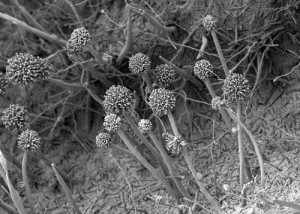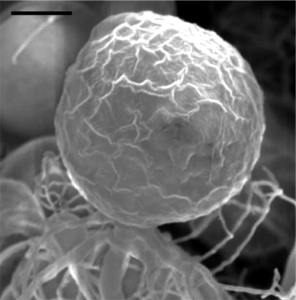
Sporulating culture of Aspergillus niger growing on wheat bran. (Jan Dijksterhuis & Ronald P. de Vries, CBS-KNAW Fungal Biodiversity Centre, Utrecht, The Netherlands)
For architects, “form to function” means designing a building that best serves its intended purpose. For genomics researchers, the term could be applied to the ongoing transition from not just studying the genetic code of an organism, but also understanding what roles those genes play in the biology of the organism that encodes them. Several projects selected for the 2013 Community Sequencing Program (CSP) portfolio of the U.S. Department of Energy Joint Genome Institute (DOE JGI) are planning large-scale studies that take this next step by moving beyond basic genome sequences to the RNA transcripts (RNASeq) that represent genes “turned on” under different circumstances, and examining the circumstances under which they are required, giving hints about what they do. Another approach being employed in some of the projects involves transposon mutagenesis (TnSeq), a method of generating large sets of random mutations in target DNA. These techniques will allow the DOE JGI to study in greater depth the genomes and activities of organisms that have potential applications in energy and environment.
The organisms featured in these proposals come from a wide variety of environments. They run the gamut from a microbe found nearly two miles below the earth’s surface in a South African gold mine, to bacteria in the coastal waters off the west Antarctic Peninsula, to crops that could be grown in several regions across the United States and provide a renewable, sustainable source of biomass for biofuels, to fungal pathogens that pose a threat to energy crop yields.
All the projects selected (29 out of 108 full proposals) combine sequence data generation with large-scale experimental and computational capabilities to enable fuller functional genome annotation. Researchers submitted proposals for projects that cover topics such as plant-microbe interactions, microbes involved in carbon capture and greenhouse gas emission, and the study of microbial communities from environmental niches, or metagenomics. The project proposals were reviewed by an outside review panel. The total allocation for the CSP 2013 portfolio will likely exceed 30 trillion bases (terabases or Tb)—the microbial, fungal and plant equivalent of 10,000 human genomes.
Two DNA synthesis projects have been selected for the CSP portfolio. One proposal came from Jef Boeke of Johns Hopkins University, who is heading the Synthetic Yeast genome project known as Sc 2.0. This project intends to design, construct, and replace the native genome of baker’s yeast (Saccharomyces cerevisiae) with a fully synthetic version. As part of Sc 2.0, the DOE JGI will synthesize chromosome IV. At half a million basepairs, this is the largest chromosome of the 12-million base genome. Yeast is one of the most common microbial “platforms” for the production of fuels and other chemicals and is playing a key role in bioenergy research.
Included in the five plant projects selected is the Gene Atlas Pilot Project led by Gary Stacey, the Director of the University of Missouri Center for Sustainable Energy. The project aims to develop a comprehensive index of gene expression for several plant species deemed DOE JGI Flagship plants. These include the alga Chlamydomonas reinhardtii, soybean (Glycine max), the moss Physcomitrella patens, poplar (Populus trichocarpa), and foxtail millet (Setaria italica).
“Now that we have generated these sequences at great expense, we need to add information to convert them into functional models,” the researchers noted in their proposal.
The expression responses of each of the five plants will be studied under a variety of environmental conditions, and the team also plans to study another five DOE JGI Flagship plants and three comparative model species. The comparative study across the 13 plant species will focus on the nitrogen metabolism in these plants and their impact on gene expression from algae to the grasses.
Another project selected for the CSP 2013 portfolio is led by Duke University’s Kathryn Picard and focuses on understanding the symbiotic relationship between a fungus and its algal partner. Isolated in Australia from the soil of an Antarctic beech forest, the fungus Rhizidium phycophilum helps the alga Bracteacoccus. Sequencing both of these genomes and particularly the section of the genomes with functional information, noted the team in their proposal, could lead to the identification of algal genes that can help increase algal biomass for biofuel applications.

SEM micrograph of the reticulated sporangial wall of the chytrid fungus Rhizidium phycophilum in co-culture with the coccoid green alga Bracteacoccus sp. Smooth-walled algal cells can be seen in the background. Scale = 20μm. (Kathryn Picard, Duke University)
From the seven fungal projects approved, one proposal aims to do for them what the ENCODE project is working toward for the Human Genome Project. Led by University of California, Berkeley researcher N. Louise Glass, the Fungal Nutritional ENCODE project aims to comprehensively map out the nutritional and metabolic regulatory networks of Neurospora crassa, which grows on decaying plant biomass, in order to identify and improve the productivity of cellulases that can be harnessed for industrial biofuel production.
Another project is the Mycorrhizal Genomics Initiative, led by Francis Martin of the French National Institute for Agricultural Research (INRA). The team plans to study that fraction of the genome that is transcribed into RNA or the transcriptome in several dozen species of fungi that form symbiotic relationships with plants to learn more about the mechanisms by which these interactions take place. Symbiotic fungi provide plants with nutrients and water and play key roles in managing carbon and nitrogen levels in the forest ecosystems.
There were 15 microbial and metagenome projects selected, and many of them call for the use of single-cell genomics to study hard-to-culture microbes and metatranscriptomics to focus on the portion of the genome that encodes gene expression.
Two of the selected projects are collaborations with several national labs. Funded by the Department of Energy, the Next-Generation Ecosystem Experiment (NGEE) is focused on learning more about the response of the arctic ecosystem to the changing climate so that scientists can develop better simulations for climate change models. Berkeley Lab earth scientist Janet Jansson is the lead on the CSP project, which focuses on the genomics of microbial communities isolated from samples cored out of the permafrost in Barrow, Alaska. The frozen soils store a large amount of carbon, and rising global temperatures have also raised concerns about the potential outcomes when the permafrost thaws and the trapped carbon could be released into the atmosphere. The NGEE consortium also includes researchers from Oak Ridge National Laboratory (ORNL), Brookhaven National Laboratory, Sandia National Laboratory and Las Alamos National Laboratory, as well as collaborators from two universities, contributing expertise in fields ranging from microbial ecology to climate modeling.
Another large-scale project exploits an earlier CSP project to fill in gaps in the Tree of Life. In 2007 the Genomic Encyclopedia of Bacteria and Archaea (GEBA) started sequencing uncultivated microbes from less explored branches (“microbial dark matter”); to date, more than 250 microbial genomes have been completed under this project. The Functional Encyclopedia of Bacteria and Archaea (FEBA) project in the CSP 2013 portfolio plans to employ a high-throughput approach known as transposon mutagenesis and sequencing to determine the gene functions in the genomes of 40 DOE-mission relevant microbes. The project is led by Berkeley Lab’s Adam Deutschbauer.
“While advances in high throughput DNA sequencing have made microbial genome sequencing easy, the functional annotation of genomes remains extremely hard,” Deutschbauer and his colleagues noted in their proposal. “There is therefore a great demand for novel high-throughput approaches to determine gene function from phylogenetically diverse microbes.”
See the full list of projects that make up the CSP 2013 portfolio, supported by the DOE Office of Science. The DOE JGI Community Sequencing Program also accepts proposals for smaller microbial and resequencing projects on a quarterly basis. For more information about the annual and quarterly CSP calls for proposals, go to http://www.jgi.doe.gov/CSP/index.html
